You are here
Home ›New HESA data: Strong growth on the surface, but what trends lie beneath?
Primary tabs

It’s like Christmas all over again. Last week we unwrapped one of our favourite statistical presents of the year: new HESA data. Well, newish. HESA reports of course trail far behind the present, but the 2018/19 data (now uploaded for subscribers on our website) gives us by far the most detailed view of trends in UK international HE recruitment than any other sources. In this post, we’ll summarise the key takeaways that leapt out at us on first analysis.
A couple of notes before you dive in. First, our numbers in this post may look slightly different from what you see in other places. That’s because we’ll refer to new international enrolments instead of total enrolments, as this gives us a clearer picture of how recruitment conditions evolved in 2018/19. This data is more inclusive, most notably covering visiting and exchange students as well as students enrolled on UK degree programmes. Also, it’s worth remembering that this data covers the 2018-2019 academic year, which means that enrolments predated the announcement of the Graduate Route that will allow students to stay in the UK after completing their courses. UK universities will almost certainly get a boost from the new policy, but it is not reflected in this data.
The overall picture from the new HESA data is a very happy one, as we expected based on 2018 study visa figures. The UK’s new international HE enrolments hit an all-time high of 306,300, up by 7 per cent from the previous year, which is the fastest growth the sector has seen in nine years. On closer inspection, however, conditions were not buoyant across the globe. Instead, just two markets, China and India accounted for three-quarters of the growth. New enrolments from mainland China climbed by 12.7 per cent while those from India soared by 39 per cent. Leaving these two countries aside, new enrolments from the rest of the world nudged ahead by just 2.6 per cent.
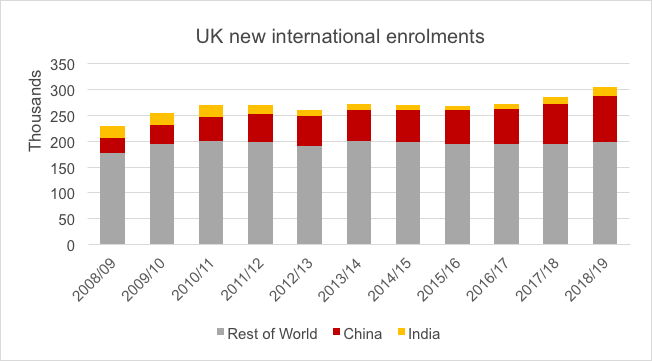
Source: HESA
On the surface, the resurgence of India would seem to lessen the sector’s heavy reliance on China, yet dig deeper in the data and a more complex story emerges, with recruitment from these markets varying considerably across the sector. Russell Group institutions have captured the lion’s share of growth from China, and their proportion of new enrolments continues to grow. As the chart below shows, 62 per cent of new enrolments from China enrolled in Russell Group universities in 2018/19, up sharply from 48 per cent five years prior.
Meanwhile, the resurgence of India appears to have so far been more of a boon for non-Russell Group institutions. While new enrolments from India into Russell Group institutions have also risen over the past two years, much stronger growth was recorded across the rest of the sector. Thus, we may be witnessing a geographic divide in recruitment patterns that is likely to intensify in the coming years, with top-ranked institutions deepening their reliance on China while the rest of the sector shifts focus to South Asia. Indeed, this is similar to the dynamic that has played out amongst Australian universities.
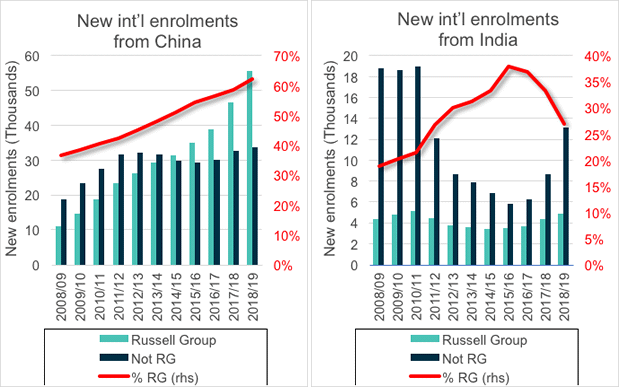
Source: HESA
Across the UK’s other leading markets, performance was broadly positive, with 19 of the top 30 markets posting year-on-year growth (see table below). Highlights included Nigeria, which recorded 32 per cent growth, and the Gulf, where Kuwait and UAE expanded by 18 per cent and 17 per cent, respectively. Elsewhere, Pakistan, Saudi Arabia, Taiwan and South Korea registered decidedly positive gains in new students. In the EU, we saw impressive growth in Romania and Portugal, as well as a healthy expansion of new enrolments from Spain, Poland and Ireland.
On the less happy side of the ledger, notable markets in decline included Cyprus and Greece, down by 18 per cent and 6 per cent, respectively. Smaller declines were recorded in France, Germany and Italy. Also of concern, several key East Asia – Malaysia, Singapore and Thailand – contracted, though the declines were relatively small in the latter two. Study visa data from 2019 suggest that the number of new UK enrolments from Malaysia and Singapore have since continued the slight downward trend, while Thailand saw study visa issuance rise.
Stepping back to the broader context (see chart below), we can see that, despite the strong headline growth in new enrolments, we are operating in a relatively low-growth global environment, buoyed by two enormous, accelerating markets. That should both inspire and worry readers. The UK’s renewed post-study work visa offer will undoubtedly increase broad interest in UK study, but it remains to be seen if this will lead to a more even distribution of growth across the portfolio, or if it will only serve to deepen dependence on China and India.
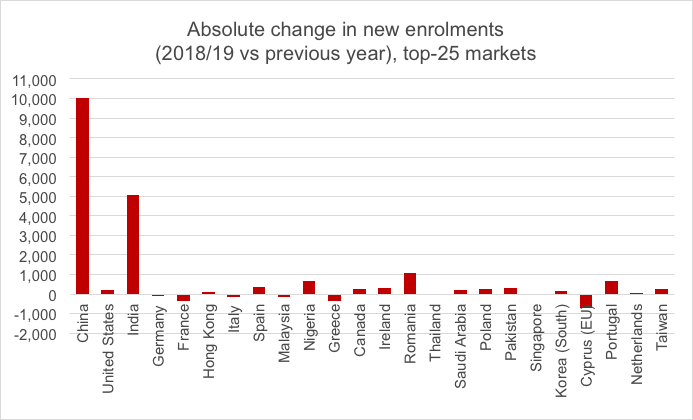
Source: HESA
Study level
In the last two years of HESA data we have also seen notable shifts in the level that incoming international students are studying at. Postgraduate enrolments, which had sagged since the repeal of post-study work visas, surged back to life since 2017/18. As the chart below shows, the five-year cumulative growth in new postgraduate enrolments has leapt past that of the undergraduate level. This means that a majority of new international enrolments (52 per cent) were studying at the postgraduate level, up from 50 per cent three years earlier.
Yet a closer look at the data shows that this is not a broad global trend but instead driven by shifts in China and India, where postgraduate enrolments leapt by 14 and 43 per cent, respectively – accounting for a combined 90 per cent of the total net increase in new students at this level. So long as these two markets continue to dominate the growth story, we can expect the shift towards postgraduate study to gradually intensify.
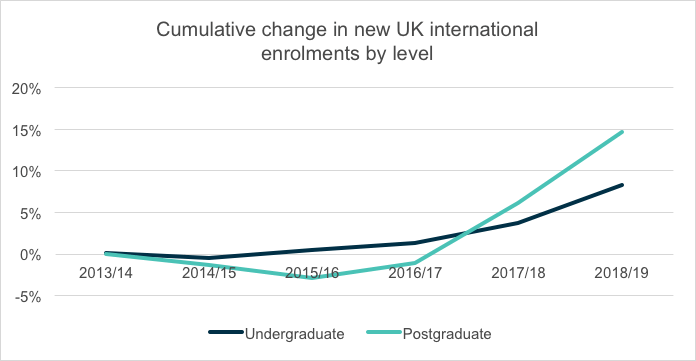
Source: HESA
Subject areas
Business and Administrative Studies continued to be the most popular broad subject area among international students, with 89,250 new enrolments in 2018/19 – more than three times as many as the next most popular field, Social Studies (driven by Economics). Although the growth rate in this subject area was slightly below that of new international students as a whole, it was still the field with the largest net growth.
Measured by percentage terms, though, the field with the strongest growth was Computer Science. New student numbers in this area were up by almost 25 per cent and the net growth in students starting Computer Science courses was second only to Business & Administrative Studies. Computer Science enrolments benefited from strong growth in Indian and Nigerian students but also saw a large jump in popularity among students from China at both undergraduate and postgraduate levels.
Other popular subject areas showing strong growth this year included Creative Arts, the Biological Sciences and Mass Communications. There was also a notable jump in medical student numbers, although this subject accounts for less of the market in absolute terms; this was mainly due to increased numbers of students from mainland China, Hong Kong and India.
One major subject area that performed relatively less well was Engineering & Technology. Although new enrolments in this field increased by around 4 per cent overall, this is significantly lower than overall growth across all subject areas. Engineering fell from the second to the third most popular broad subject area this year after being overtaken by Social Studies.
Mobility through partnerships
The latest HESA data also raises warning flags about the role of partnerships in mobility: based on our calculations, it looks like the number of international undergraduate students coming to the UK through articulation agreements and transnational education continued a pattern of decline in 2018/19. To be clear, HESA doesn’t report data specifically on mobility through partnerships, but in theory we can get very close to this number by looking at the number of new international students who are not starting on the first year of course (i.e., first year, first degree students on years 2 through 4 of course). As the chart below shows, the total number of these students has gradually declined over the past five years of data. Growth in new UG students instead seems to be have come almost exclusively from students entering in year one of their courses, primarily driven by China, India and, interestingly, Portugal.
If this trend is indeed accurate (we cannot yet rule out the possibility that misreporting is distorting the data) it raises important questions. The massive investment we’ve seen in partnership activity across the sector in recent years has largely been based on the assumption that articulation and TNE agreements are the future engine of mobility. But the data suggest that is not the case – at least not yet.
There are a lot of follow-up questions on this topic that we can’t yet answer. Most important, we can’t differentiate between students coming through traditional articulation agreements (which require relatively little investment) and TNE (which usually requires a tremendous investment of resources), so we can’t say with certainty which pathway is performing better on the whole. We are, however, currently working with our fellow international education wonks at UUKi on a project to dig deeper into this issue and hope to have results to share in the coming months. Watch this space.
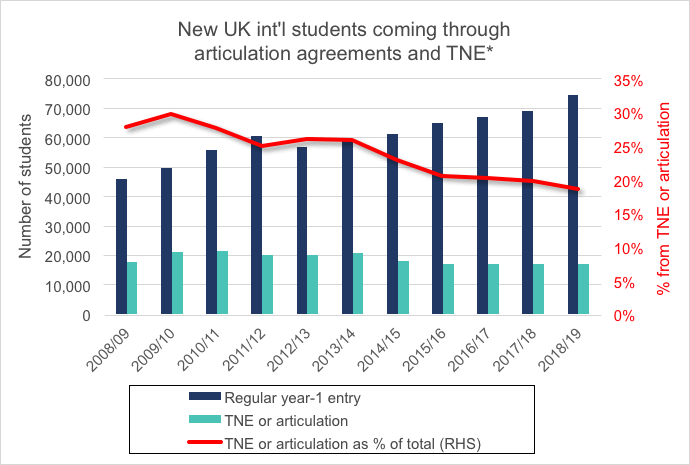
*First year, first degree students, on year 2, 3 or 4 of course. Excludes visiting and exchange students.
Source: HESA
Concluding thoughts
The headline HESA data for 2018/19 contained no surprises – study visa and UCAS data from 2018 had already told us that it was a good year for the UK HE sector overall. Yet the details available in the HESA release do unveil key trends that we couldn’t discern from the more up-to-date sources. While a deepening dependence on China and the return of India come as no surprise, a widening divide between the recruitment portfolios of Russell Group and non-Russell Group institutions is a noteworthy trend. Similarly, the impact that both markets have on study level and subject area provision are also becoming increasingly apparent. With all signs pointing towards continued strong growth from these markets (some near-term concerns about coronavirus aside), we can expect to see these trends to intensify over the coming years. This presents both opportunities and risks for UK providers.
Finally, the apparent decline of mobility through partnership poses some important questions about how the future of international education will play out. If these figures hold up on closer inspection, and if the trend continues, a rethink of partnership strategy and a rationalisation of investment is sure to follow.
While the UK sector is currently facing some uncertainties, we are coming off the back of two very positive years for international student recruitment. The return of post-study work visas is almost certain to further fuel that trend. But the latest HESA data release should serve as a reminder that international HE is steadily evolving, and we’ve yet to truly grapple with some of the key challenges accompanying change.
Authors: Matt Durnin and Kevin Prest






Comments
Add new comment
Please note that comments by non-members are moderated. They do not appear on the site until they have been approved. Comments by registered members appear here immediately. Your email address will not be published. All fields are required.